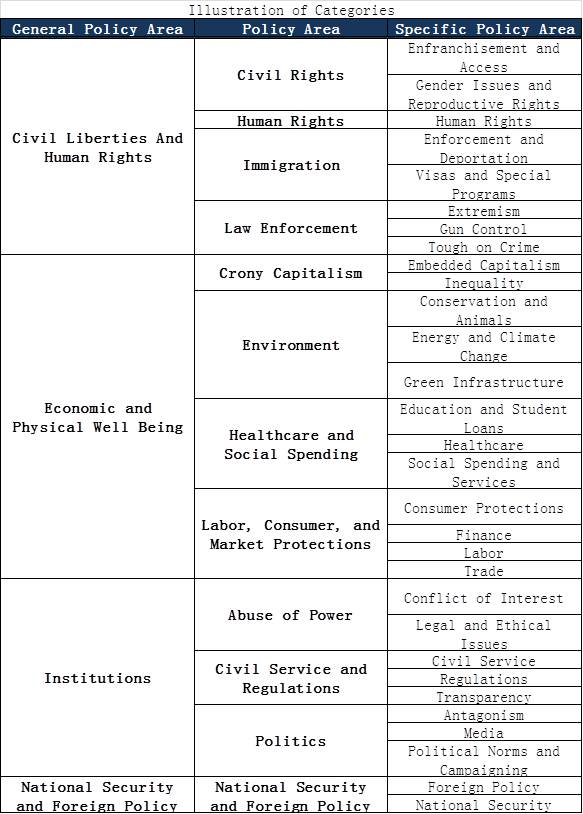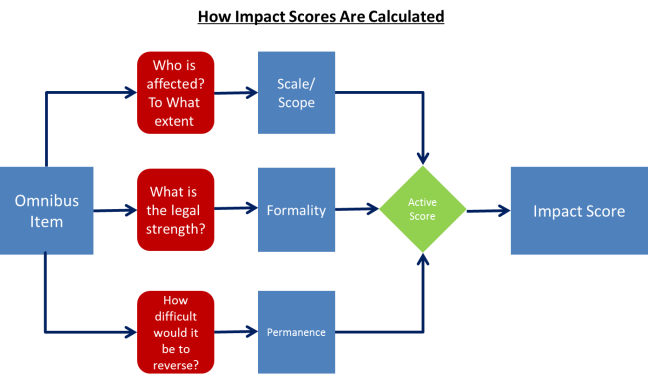Compiling The Omnibus
As a first step in our process, we have attempted to compile a comprehensive list of every action the administration has enacted since the beginning of the administration which have been deemed to have a negative impact in some way. These include actions taken by the Trump Administration and the people with it ranging from controversial statements to major policy changes. We try to include everything, even if we feel something isn’t exceptionally important, simply because we want to be as comprehensive as possible. We include major actions by the Republican congress, with the reasoning being that the Administration is enabling them and vice versa. Similarly, bad decision made by the Supreme Court which hinged on a vote by Neil Gorsuch are also included, since ultimately Trump is responsible for place Gorsuch onto the court in the first place.
Each of these actions must have at least one or more credible source that they are linked to. To this end, we’ve regularly scoured news sites and government webpages. We also frequently search sites critical of the Trump Administration, such as anti-Trump sub-reddits, as these would naturally be places that would volunteer such news stories. Naturally, it is necessary to be discerning when we do this, and we discount items that seem too speculative, or represent what is, at best, a very niche view. With few exceptions, we tend to require that a story be covered in the mainstream media, such as the New York Times, or sites like Vox which have some acknowledged level of bias but which is tempered with something of a wonky ethos that tends to stop them from tipping in to unsubstantiated polemics. We try to avoid a source that would be obviously biased, such as the web page of a public advocacy, but sometimes we’ll accept such sites if they link their posts to hard regulations.
Once the actions are collected and itemized, they’re entered into a list, along with their source and the timestamp on the source.
Categorizing Actions
As have divided the items on the list into four broad categories. These categories correspond not only to the general policy area they relate to, but also the way in which their impact manifests:
Civil Liberties and Human Rights – Issues relating to topics concerned with individual and collective rights, with the main consequences experienced primarily as an abridgement of rights
Economic and Physical Well Being – Issues relating to the material circumstances of the world we live in, and the functioning of the economic system, with the main consequences experienced as a degradation of conditions, material loss, or inequality
Institutions – Issues related the legal frameworks, organizational structures, and practices underlying a properly functioning of and fair government, with the main consequence experienced as dysfunction
National Security and Foreign Policy – Issues related to the standing and security of the United States, with the main consequences experienced as a deterioration of national security or global standing
Below these, the items are broken into twelve sub-categories relating to the general policy areas they relate to.
Civil Liberties and Human Rights
Civil Rights – Issues related to the rights of US citizens, such as equal rights, enfranchisement and access issues and gender equality and reproductive rights
Human Rights – Issues related to more broad human rights, US citizen or otherwise, typically under international initiatives
Law Enforcement – Issues related to the enforcement of laws, criminal and non-criminal, and the functioning of the criminal justice system, including draconian tough on crime measures, and moves that undermine gun control and attempts to combat right wing extremism
Immigration – Issues related to non-citizens, and new citizens residing in the United States through enforcement and deportation actions and visas and special programs
Economic and Physical Well Being
Environment – Issues related to the natural environment, including conservation and animal protections, energy and climate change, and green infrastructure
Crony Capitalism – Issues related to rigging the economic system to redistribute income upwards at the expense of the little guy and fair play. This includes undermining the system of embedded capitalism by showing preferential treatment to corporations and allowing them to shirk their responsibilities, or tax cuts and other moves that exacerbate inequality
Healthcare and Social Spending – Issues related to providing economic assistance and services to people, including healthcare, education and student loans, and other social spending
Labor, Consumer, and Market Protections – Issues related to laws and practices aimed at protecting people from exploitation, enhancing economic empowerment, and offsetting market failures, including labor, finance, consumer protections, and trade
Institutions
Abuses of Power – Issues related to flagrant misuse of government power for personal empowerment/enrichment, including conflicts of interest and legal and ethical Issues
Civil Service and Regulations – Issues related to the day to day operations of the government, including the staffing and practices relating to the civil service, the process of issuing regulations, and transparency
Politics – Issues related to political norms and practices, including political norms and campaigning, the media, and issues of straight forward antagonism
National Security and Foreign Policy
National Security and Foreign Policy – With subcategories of national security which relate to more domestic threats and foreign policy which deals with overall diplomacy
Summary of Categories
Overall, there are four broad categories, twelve mid level categories, and thirty sub categories. An illustration of how the categorization system is arranged is provided below.

There are naturally some issues with which categories any given item should fit in, o what the specific difference is between different categories. For example, Crony Capitalism and Abuses of Power tend to have a lot of overlap. One can rig the economic system out of an ideological commitment, or they may do it just to advantage themselves and their clients. Generally, the closer you get to Trump individual, the more likely an action is to be viewed as an Abuse of Power, but there’s not really a clear line (the rule of thumb is “if it’s in Trump’s cabinet or family, it’s an Abuse of Power”). Still, for the most part the categories are broad enough that these sorts of ambiguities aren’t an issue.
Measuring Impact
Challenges
Measuring the relative impact of the different actions of the Trump administration is a daunting task, for numerous reasons. First, because doing a truly thorough and rigorous estimation would require a large commitment in time and effort to estimate. Ideally, every item on the list would go through some form or another of impact analysis to determine things like the forecasted monetary cost of a policy, how many people would be affected, etc. I’ll be up front in saying that I don’t have nearly the capacity for that. I mean, don’t get me wrong, I’d like to think I’m pretty smart and hard working, but of course I’m not. There’s an entire industry of think tanks, universities, and government agencies dedicated to doing this, and not even they get everything. So realistic, I, a guy with a laptop doing this in his limited spare time, would be hopelessly out of my depth to attempt that. I can, of course, pull the analyses put together by said think tanks, universities, government agencies, etc. and use them to inform how I weight things, but that’s a luxury, not something I can realistically expect in all cases.
Second, as I noted above, the way policies impact people are fundamentally different across categories. There is some overlap; of course, rigging the economic system in a way that exacerbates inequality will also reflect a loss of institutional functionality, on some level, draconian tough on crime measures can have an economic cost along with a loss of rights, and so forth. But on some level this is comparing apples and oranges. It’s not impossible, but it’s not straightforward.
The impact involved in the category of “Economic and Physical Well Being” could typically be expressed in monetary terms. This isn’t to say all the costs are experienced as strictly an economic loss, repealing the Medicaid expansion will cost lives as much as money, but you could figure “expected years lost” or some other measure which you could convert into monetary terms if you just want an overall apples to apples measure of impact (platitudes of “you can’t put a cost on X aside”, economists do just that all the time). But items in the category “Civil Liberties and Human Rights” are basically going to be measured in things like political disenfranchisement, denial of basic human rights, and so forth. This kind of impact is clear enough, there are ways the loss of ones rights materially affects a person, and you can reasonably say when one abridgement of a person’s rights is worse than another. But rights are an abstract concept; they’re not “quantifiable” so to speak. And things get even more abstract when you’re talking about the institutions. The degradation of the legal framework and informal practices which are necessary for a functioning (and desirable) government and civil society is obviously a cost, but there’s no metric for it.
Third, half of any discussion of costs is subjective. Even in the relatively straightforward realm of economic impacts, you have to take into account things that are going to lead different people to different conclusions. To give an example, global warming will have a severe economic impact, but that impact will mostly be experienced decades down the line, so any meaningful economic model to measure that impact in any meaningful way. You need to include some sort of discount rate. How high should that discount rate be? That’s essentially a matter of opinion. And how do you prioritize economic costs against rights against national security against the proper functioning of the government/society? Opinions will differ. Ideally, we might have some sort of open democratic way of evaluating the relative importance of different items, but for the time being I have to play that by ear.
This isn’t to say the whole undertaking is hopeless. There are concrete things tie the impact scores of different policies to, and there are filters were can use to weight their relative importance to different groups of people. Indeed, considering the various prisms people view issues through is important in understanding how to appeal to people. But there’s no perfectly objective and omniscient perspective you can view policy through.
Additionally, there are also some issues of double counting. If you look through the omnibus, you’ll notice that some items get referenced multiple times. For example, an Obama era policy might be frozen, and then a few months later it may be repealed. Citing these instances separately can be worthwhile. They can help track the progress of a policy, and you’ll notice that the list has gotten “smarter” as it progresses, making references to previous items. Likewise, some items, like the harsh immigration measures enacted in the early days of the administration, have been continuously impacting people ever since, and therefore should be referenced multiple times.
Measurements
In order to try to ground my impact scores, I started by giving them ordinal scores, from 1 to 10, based on three dimensions.
Scale/Scope of Impact – Basically, how many people are impacted and to what degree. Generally, a score of 1-2 means nobody is really affected, except indirectly in some vague way. A score of 3-4 indicates hundreds could be severely affected, thousands would be moderately affected, and/or millions may be potentially affected in some vague indirect way. A score of 5-6 indicates thousands would be severely impacted, millions could be moderately affected, and/or tens of millions could be potentially affected in some vague indirect way. A score of 7-9 Indicates tens of millions or more would be severely affected or hundreds of millions or billions would be moderately affected. A score of 10 means all of humanity could be severely affected.
Formality – Generally speaking, the more formal a policy is, the more relevant it is. If an administration makes a law to enact policy, that’s a bigger deal than if the administration chooses to implement policies in different ways. Laws impose more restrictions, set precedents that inform future behavior they leave a lasting impact on institutions, etc. This measure is meant to capture that. A score of 1-2 reflects a totally informal practice. A score of 3-4 means enacting a different way of interpreting or implementing laws without necessarily changing them. A score of 5-6 means an executive order or new regulation issued by an agency. A score of 7-8 would indicate laws passed, 9 would indicate a major law passed, and 10 would be equivalent to a full constitutional amendment.
Permanence – How hard it would be to reverse a policy. This can mean politically, such as how hard it would be to repeal a law or a court decision. Or it can mean what’s materially possible. For example, if a new policy destroys a delicate eco-system simply changing the law back won’t undo the damage. A score of 1 indicates that something’s completely ephemeral. 2-3 indicates they could be reverse more or less at will, provided sufficient public pressure is applied. 4-5 might indicate a more concerted push in terms of campaigning, legal challenges, etc. 6-7 would indicate that a Democratic congress/administration would likely be needed to change them, but could do so with relatively little effort. A score of 8-9 would indicate massive policy initiatives would need to be undertaken, and 10 would indicate something is effectively irreversible.
Additionally, it’s generally accepted by most people that the significance of an action is typically dependent on how much a person takes an active part in it. Failing to prevent a bad thing is not as bad as causing a bad thing, and ending something positive is not seen as being as bad as starting something negative. We shouldn’t get too involved in all the various hypotheticals* that people have made to illustrate the issue, but it’s still worth adding this additional dimension:
Active/Passive – Generally speaking, most people tend to view the morality of actions on the basis of how actively on participates in them, and while this can lead to a number of absurd hypotheticals* it’s a good standard to apply. A score of 1 indicates that the Trump administration isn’t really doing anything (maybe they’re just incompetently sending mixed messages), a score of 2 is indicating that Trump is failing to act when he should be or perhaps is only proposing doing something, a score of 3 indicates the Trump administration is reversing a good policy enacted by Obama or others, and a score of 4 means that this is something the Trump administration is actively imposing on the world.

Once these scores are assigned, they are used to calculate a score for overall impact. The scores for scope, formality, and permanence and multiplied together, then weighted the active/passive score. The active/passive score is multiplied by 0.25, such that a totally active policy would see it’s full impact realized and an unintentional gaffe would see 75% of it’s value discounted. The resulting value would be the overall impact of an action.

For good measure, once the scores are assigned to an action, the scores are then arranged from least to greatest. We then go down the list, comparing each item with the score of it’s immediately adjacent items. If it seems like one action has been given a score higher than another we intuitively believe should actually be ranked higher, we adjust the underlying scores until the overall impact scores seem appropriate. We went through the list a few times, and once we’ve determined that no items seem to be out of order take the scores as more or less sufficient.
Admittedly this score is far from perfect. As much as We’ve tried to ground the score in some tangible dimension, and take steps to try to keep all the scores in perspective, it’s still inevitably a subjective score based largely on personal intuition. For this reason, we’d caution against taking the scores as an exact measurement of significance, but rather as a general representation of relative significance, and the best that can be done given the circumstances.
The scores are accessible online, and we were encourage observers to tinker with the metric themselves. Democratized systems of review incorporating a broad variety of perspectives can be powerful tools for finding the “true” value of something.
Side Note: Acknowledging Our Political Goals
We don’t deny that the omnibus and this report, their intended audience, and their intended ends, i.e. convincing everyone the Trump Administration is bad and should be thrown out, are overtly political. Of course it is. Likewise, we acknowledge that the assumptions on which the omnibus and this report are based predominantly appeal to left wing sensibilities. That’s not a problem, in and of itself, and for the most part I don’t believe the primary audience of this report will see it as such. But it’s understood that this may be a turnoff to more neutral observers.
Still, I’d like to emphasize that the report should have value that are not undermined by its ideological bent. Ideologies and biases are necessary frameworks for understanding the world, rather than the sort of corrupting, distorting image they’re often portrayed as. By default, everyone has biases, we’re just acknowledging ours to be honest. Ideologies can mislead people, of course, but this primarily happens when they allow their beliefs to become ungrounded. To that end, we’d stress that it’s more important to be honest and retain a firm footing in relatively uncontroversial empirical data and methodological rigor rather than try to totally scrub any personal ideology out of the analysis, which is impossible and strips out important qualitative context. We hope that it’s apparent that we try to do this.
A helpful analogy would be to think of our assessment as being like a prosecutor in a court case. We want our argument to be based on sound evidence and universally appealing reasoning. However, we’ll also be visceral if it helps strengthen our case by illustrating why we draw the conclusions we do. In any event, we’re not going to make the other side’s case for them in a shallow attempt to appear impartial.

9 thoughts on “Full Methodology And Notes For The “Everything Terrible The Trump Administration Has Done So Far” Reports”